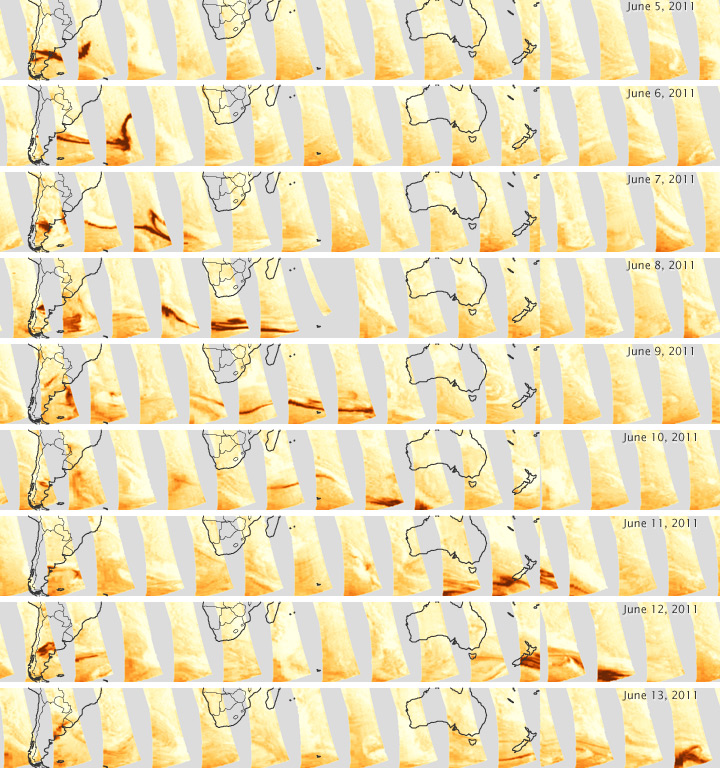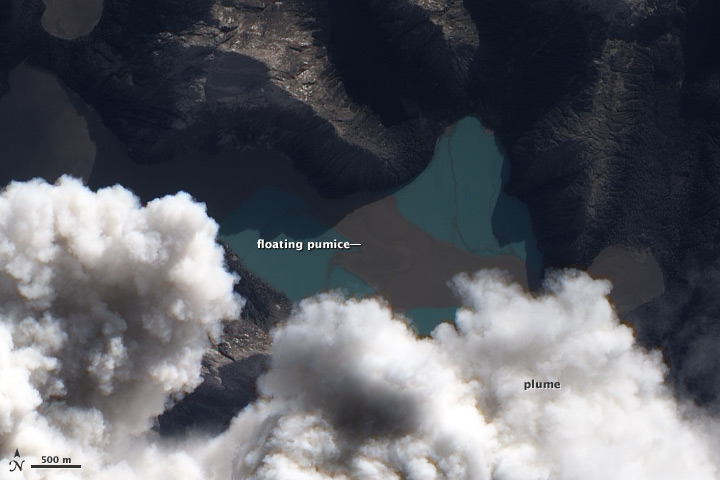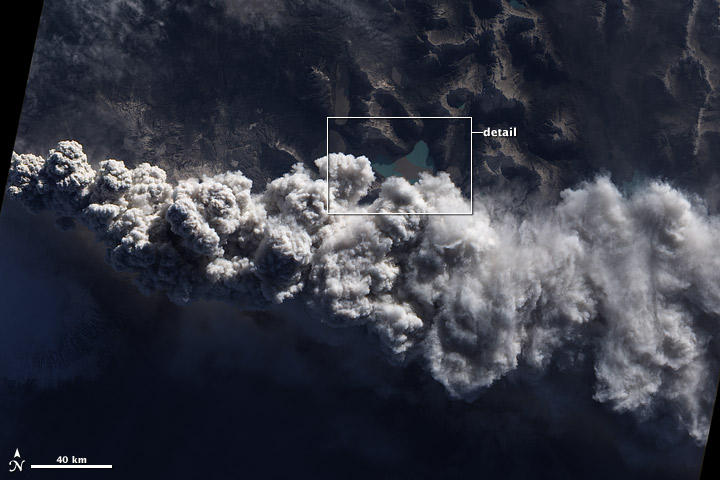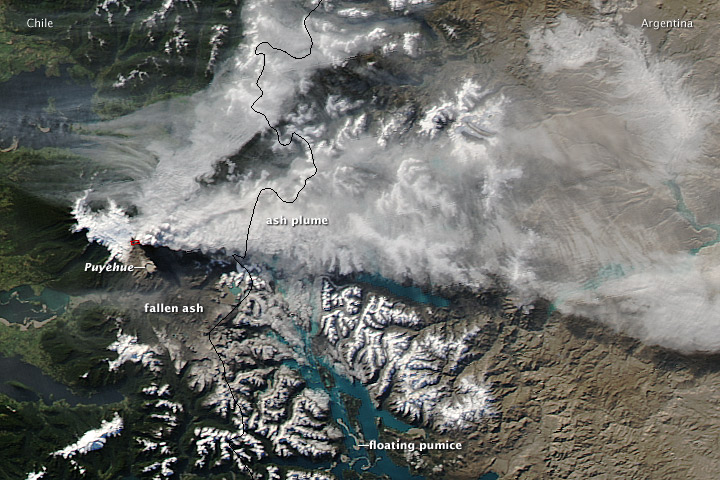NASA: Chile - Argentina - Ash Plume and Flotaing Pumice from Puyehue-Cordón Caulle - Pluma de cenizas y piedra pomez flotante del volcan Puyehue-Cordon Caulle - 26-07-11
Posted by Ricardo Marcenaro | Posted in NASA: Chile - Argentina - Ash Plume and Flotaing Pumice from Puyehue-Cordón Caulle - Pluma de cenizas y piedra pomez flotante del volcan Puyehue-Cordon Caulle - 26-07-11 | Posted on 19:30
Open your mind, your heart to other cultures
Abra su mente, su corazón a otras culturas
You will be a better person
Usted será una mejor persona
RM
Abra su mente, su corazón a otras culturas
You will be a better person
Usted será una mejor persona
RM

acquired June 5 - 13, 2011
In its early, violent days, the eruption at the Puyehue-Cordón Caulle volcanic complex sent clouds of ash high into the atmosphere. Rising some 15 kilometers into the air, the ash settled into a jet of fast-moving wind on a trip around the world. This series of images tracks the ash from Chile to the eastern South Pacific Ocean, nearly completing a trip around the globe in eight days.
The images show the density of particles in the atmosphere (aerosols) as measured by the Ozone Monitoring Instrument (OMI) on the Aura satellite. The series starts on June 5, 2011, the day after the eruption began, and continues through June 13.
The volcanic ash is an area of concentrated particles represented in dark red. Shades of orange and yellow point to areas with lighter concentrations of particles, including ash, smoke from fires, and desert dust. The light gray regions are places where the OMI instrument did not collect useful data. Because the sensor requires light to measure particles in the atmosphere, it did not record the far south, which is submerged in the low light of late autumn. The ash was traveling around the globe in the far south near the edge of polar darkness.
The ash remained concentrated as it circled the globe in the stratosphere—enough so that it was visible in photo-like images over New Zealand and Australia. It was also concentrated enough to disrupt air travel in those countries. Harsh, abrasive volcanic ash can clog jet engines and cause serious damage to a plane in flight.
The eruption at the Puyehue-Cordón Caulle Volcanic Complex has since slowed, but the volcano continues to coat the surrounding region with prodigious amounts of ash. By June 15, the eruption plume reached between four and five kilometers (2-3 miles) in height.
The images show the density of particles in the atmosphere (aerosols) as measured by the Ozone Monitoring Instrument (OMI) on the Aura satellite. The series starts on June 5, 2011, the day after the eruption began, and continues through June 13.
The volcanic ash is an area of concentrated particles represented in dark red. Shades of orange and yellow point to areas with lighter concentrations of particles, including ash, smoke from fires, and desert dust. The light gray regions are places where the OMI instrument did not collect useful data. Because the sensor requires light to measure particles in the atmosphere, it did not record the far south, which is submerged in the low light of late autumn. The ash was traveling around the globe in the far south near the edge of polar darkness.
The ash remained concentrated as it circled the globe in the stratosphere—enough so that it was visible in photo-like images over New Zealand and Australia. It was also concentrated enough to disrupt air travel in those countries. Harsh, abrasive volcanic ash can clog jet engines and cause serious damage to a plane in flight.
The eruption at the Puyehue-Cordón Caulle Volcanic Complex has since slowed, but the volcano continues to coat the surrounding region with prodigious amounts of ash. By June 15, the eruption plume reached between four and five kilometers (2-3 miles) in height.
References
- Australian Broadcasting Corporation News. (2011, June 15). Volcanic ash flight backlog moving. Accessed June 16, 2011.
- Darwin Volcanic Ash Advisory Center. (2011, June). Cordón Caulle, Chile, June 2011. Accessed June 16, 2011.
- El Servicio Nacional de Geología y Minería. (2011, June 15). Reporte especial de actividad volcáica no. 42 Complejo Volcánico Puyehue-Cordón Caulle. (Spanish) Accessed June 16, 2011.
- New Zealand Herald. (2011, June 13). Volcanic ash cloud could disrupt flights all week. Accessed June 16, 2011.
NASA Earth Observatory image created by Jesse Allen, using data provided courtesy of Colin Seftor and the OMI Science Team. Caption by Holli Riebeek.
- Instrument:
- Aura - OMI
Floating Pumice near Puyehue-Cordón Caulle

acquired June 14, 2011
The violent explosions at Chile’s Puyehue-Cordón Caulle Volcanic Complex have thrown volcanic rocks more than 20 kilometers (12 miles) from the center of the eruption. This natural-color satellite image was taken on June 14, 2011, and shows pumice floating on a mountain lake east of Puyehue. Parts of the lake not covered with pumice are colored aqua by the fine ash suspended in the water. Along the southern edge of the image is the ash plume, evidence of the continuing eruption which started on June 4, 2011.
This image was acquired by the Advanced Land Imager (ALI) aboard the Earth Observing-1 (EO-1) satellite. The top image shows a detail of floating pumice. The lower image shows the ash plume extending from Chile over the border into Argentina.
This image was acquired by the Advanced Land Imager (ALI) aboard the Earth Observing-1 (EO-1) satellite. The top image shows a detail of floating pumice. The lower image shows the ash plume extending from Chile over the border into Argentina.
NASA Earth Observatory image by Jesse Allen and Robert Simmon, using EO-1 ALI data. Caption by Robert Simmon.
- Instrument:
- EO-1 - ALI
acquired June 20, 2011
As ash from Chile’s Puyehue-Cordón Caulle Volcanic Complex continues to disrupt flights half a world away, the eruption itself persists. The Moderate Resolution Imaging Spectroradiometer (MODIS) aboard the Aqua satellite acquired this natural-color image on June 20, 2011. At the time a light-colored ash plume extended to the east, into Argentina. The Joint Air Force & Army Weather Information Network reported the ash at an altitude of 27,000 feet (8,200 meters). South of the plume floating pumice, produced earlier in the eruption, covered portions of Nahuel Huapi, a large lake in Argentine Patagonia. The location of the eruption site is indicated by a red outline.
References
- Darwin Volcanic Ash Advisory Center. (2011, June 21). Volcanic Ash Advisory. Accessed June 21, 2011.
- Stuff.co.nz. (2011, June 22). Ash plumes ground some aircraft again. Accessed June 21, 2011.
NASA image courtesy Jeff Schmaltz MODIS Rapid Response Team, NASA-GSFC. Caption by Robert Simmon.
- Instrument:
- Aqua - MODIS
NASA: Chile - Argentina - Ash Plume and Flotaing Pumice from Puyehue-Cordón Caulle - Pluma de cenizas y piedra pomez flotante del volcan Puyehue-Cordon Caulle - 26-07-11
You have an alphabetical guide in the foot of the page in the blog: solitary dog sculptor
In the blog: Solitary Dog Sculptor I, the alphabetical guide is on the right side of the page
Thanks
Usted tiene una guía alfabética al pie de la página en el blog: solitary dog sculptor
En el blog: Solitary Dog Sculptor I, la guia alfabética está en el costado derecho de la página
Gracias
Ricardo M Marcenaro - Facebook
Blogs in operation of The Solitary Dog:
solitary dog sculptor:
http://byricardomarcenaro.blogspot.com
Solitary Dog Sculptor I:
http://byricardomarcenaroi.blogspot.com
Para:
comunicarse conmigo,
enviar materiales para publicar,
propuestas comerciales:
marcenaroescultor@gmail.com
For:
contact me,
submit materials for publication,
commercial proposals:
marcenaroescultor@gmail.com
Diario La Nación
Argentina
Cuenta Comentarista en el Foro:
Capiscum
My blogs are an open house to all cultures, religions and countries. Be a follower if you like it, with this action you are building a new culture of tolerance, open mind and heart for peace, love and human respect.
Thanks :)
Mis blogs son una casa abierta a todas las culturas, religiones y países. Se un seguidor si quieres, con esta acción usted está construyendo una nueva cultura de la tolerancia, la mente y el corazón abiertos para la paz, el amor y el respeto humano.
Gracias :)





Comments (0)
Publicar un comentario